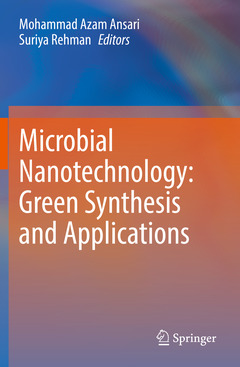Description
Microbial Nanotechnology: Green Synthesis and Applications, 1st ed. 2021
Coordinators: Ansari Mohammad Azam, Rehman Suriya
Language: English
Subjects for Microbial Nanotechnology: Green Synthesis and Applications:
Prix indicatif 116,04 €
Disponible chez l'éditeur (délai d'approvisionnement : 15 jours).
Add to cartPublication date: 09-2022
359 p. · 15.5x23.5 cm · Broché
Prix indicatif 158,24 €
Disponible chez l'éditeur (délai d'approvisionnement : 15 jours).
Add to cartPublication date: 09-2021
Support: Print on demand
Résumé
/li>Sommaire
/li>Biographie
/li>Commentaire
/li>
Dr. Mohammad Azam Ansari is currently working as Assistant Professor at the Institute for Research & Medical Consultation, Imam Abdulrahman Bin Faisal University, Dammam, Saudi Arabia. He has earlier served as Assistant Professor in the Department of Applied Medical Sciences, Buraidah Private Colleges, Saudi Arabia (2014-2017). He has more than 8 years of research and teaching experience in general biology, microbiology, bacteriology, mycology, and nutritional biochemistry. His research interests are in green synthesis of nanomaterials, identification, and characterization of antibacterial, antifungal, antibiofilm, anti-quorum sensing, and anticancer activity of green nanoparticles. He has published more than 85 research articles in journals of international repute and authored or co-authored numerous book chapters.
Examines green approaches for the synthesis of nanoparticles using microbes
Presents biomedical and medical applications of microbially-synthesized nanoparticles
Discuss the advantages and prospect of nanoparticles synthesized by microorganisms
Summarizes the role of microbial nanotechnology in the bioremediation of heavy metals
Ces ouvrages sont susceptibles de vous intéresser

Microbial Nanotechnology 184,47 €



